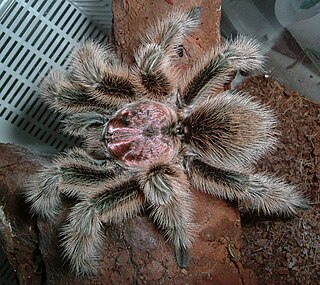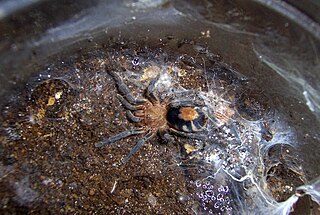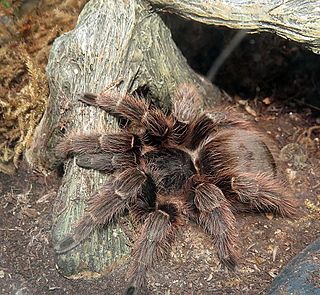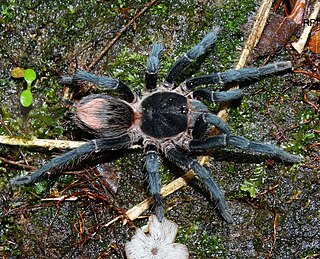
Grammostola is a genus of South American tarantulas that was first described by Eugène Louis Simon in 1892. These medium to large sized spiders are native to tropical South America, and are usually brown in color, with pinkish or orangish-red hairs. The very docile Chilean rose tarantulas are popular as a beginner's spider among tarantula enthusiasts.

Chira is a genus of jumping spiders that was first described by George Peckham & Elizabeth Peckham in 1896. It is currently named after Rio Chira, a river in Peru, but the Peckhams originally called the genus Shira, later emended by Eugène Simon.
Aphantochilus is a genus of ant-mimicking crab spiders that was first described by Octavius Pickard-Cambridge in 1871. As of June 2020 it contains three species, found in Paraguay, Brazil, Argentina, and Panama: A. cambridgei, A. inermipes, and A. rogersi. It is a senior synonym of Cryptoceroides.

Diplura is a genus of South American curtain web spiders that was first described by C. L. Koch in 1850. It is found in South America and Cuba belonging to the subfamily Diplurinae. They possess a lyra on their prolateral maxillae. Diplura species can be distinguished from Trechona sp. by the number of setae on this lyra. They differ from Harmonicon sp. by the leg formula and the shape of the lyra bristles.

Cyriocosmus is a genus of tarantulas that was first described by Eugène Louis Simon in 1903.
Cyclosternum is a genus of tarantulas that was first described by Anton Ausserer in 1871.
Tmesiphantes uru is a species of tarantula in the theraphosinae subfamily. It is endemic to Argentina.
Tmesiphantes mutquina is a species of theraphosid spider, in the subfamily Theraphosinae. It is native to Argentina.
Tmesiphantes yupanqui is a species of spider in the subfamily Theraphosinae of the family Theraphosidae. It is endemic to Argentina.
Tmesiphantes crassifemur is a species of theraphosine theraphosid spider. It is native to Argentina.
Aphonopelma anitahoffmannae is a species of spider in the family Theraphosidae, found in Mexico.

Acanthogonatus is a genus of South American araneomorph spiders in the family Pycnothelidae. It was first described by Ferdinand Anton Franz Karsch in 1880. Originally placed with the brushed trapdoor spiders, it was transferred to the funnel-web trapdoor spiders in 1985, then to the Pycnothelidae in 2020.

Eupalaestrus is a genus of South American tarantulas that was first described by Reginald Innes Pocock in 1901.
Tmesiphantes is a genus of Brazilian tarantulas in the subfamily Theraphosinae that was first described by Eugène Louis Simon in 1892. The genera Magulla and Melloleitaoina were brought into synonymy in 2019.
Amaloxenops is a genus of South American dwarf sheet spiders that was first described by R. D. Schiapelli & B. S. Gerschman de P. in 1958. As of May 2019 it contains only two species, both found in Argentina: A. palmarum and A. vianai.

Homoeomma is a genus of South American tarantulas that was first described by Anton Ausserer in 1871. It is considered a senior synonym of Calopelma, Butantania, and of Cyclothoracoides.
Plesiopelma is a genus of South American tarantulas that was first described by Reginald Innes Pocock in 1901.

Polybetes is a genus of South American huntsman spiders that was first described by Eugène Louis Simon in 1897. It is a senior synonym of Leptosparassus and Streptaedoea.
Xenoplectus is a monotypic genus of South American liocranid sac spiders containing the single species, Xenoplectus armatus. It was first described by R. D. Schiapelli & B. S. Gerschman de P. in 1958, and has only been found in Argentina.

Avicularia rufa is a species of spider in the family Theraphosidae. Specimens from the Brazilian states of Mato Grosso and Rondônia have regularly been misidentified as Avicularia juruensis. One difference is the vivid yellow rings on the legs of A. rufa compared to the paler rings of A. juruensis.








